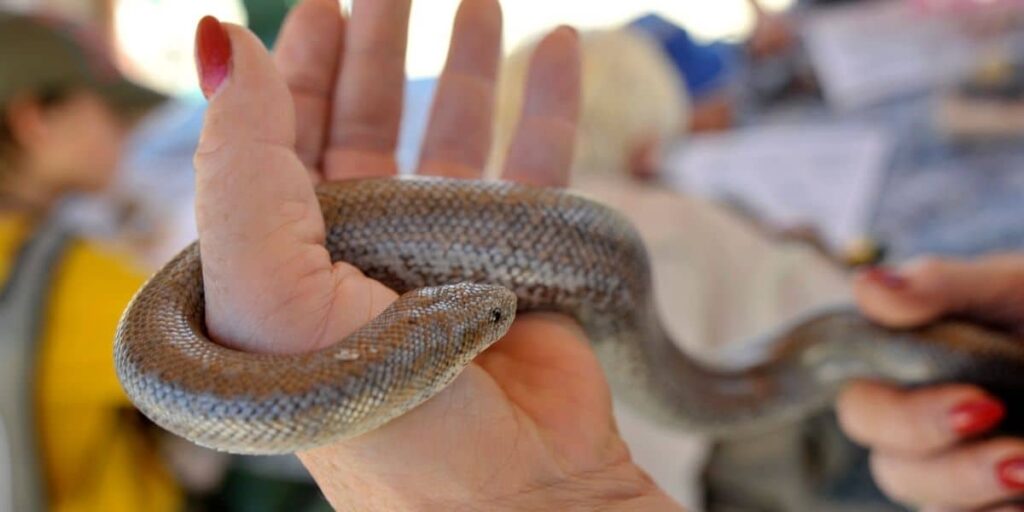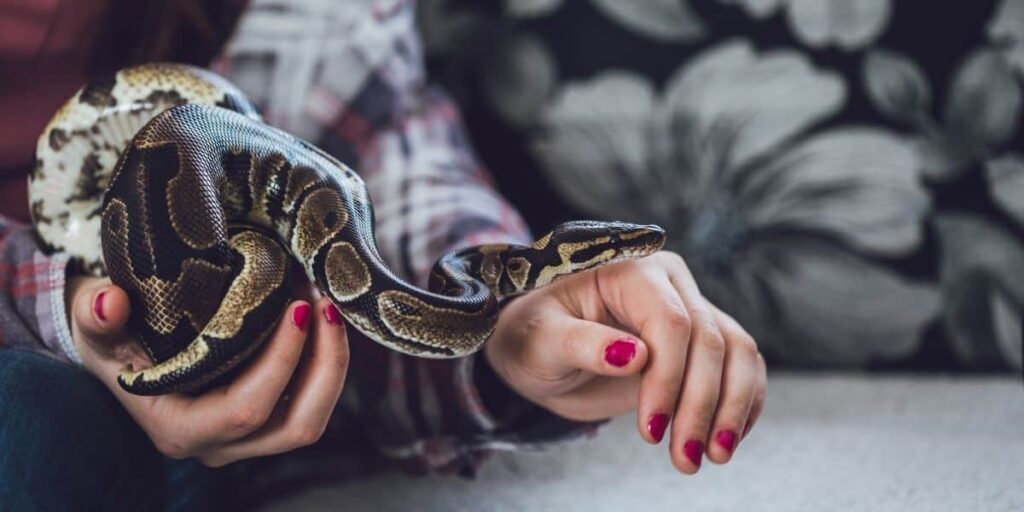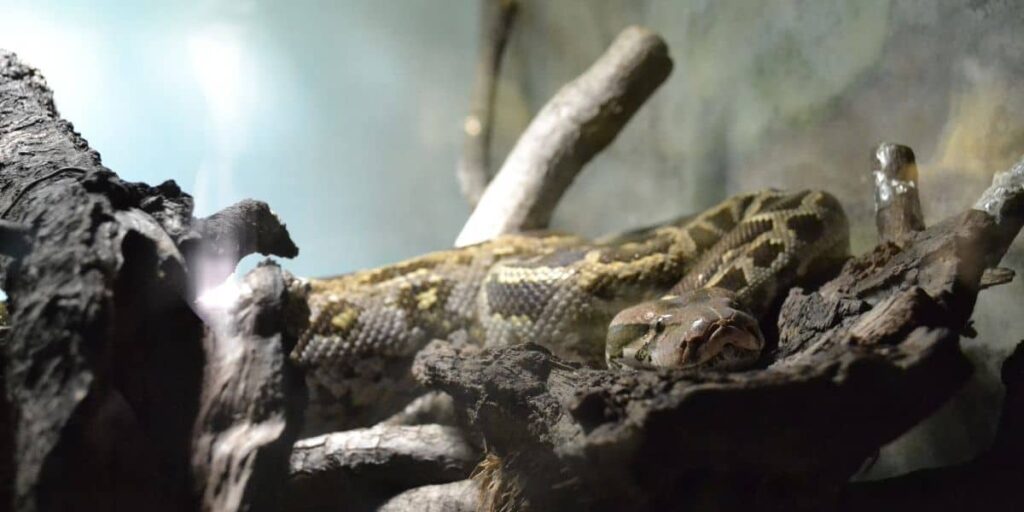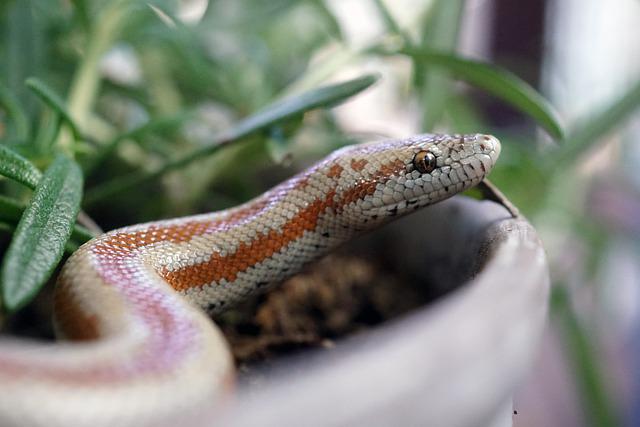It’s easy to think of snakes as kind of cold creatures (they are, after all, cold-blooded reptiles); therefore, it’s always an interesting conversation about whether or not a pet snake will bond or show affection to their owners.
A dog, for example, has particular ways of showing affection to an owner, but snakes are pretty lonely creatures by their very nature. Finding a way to bond with a pet snake can seem incredibly daunting and frustrating.
For starters, a lot of snakes don’t like to be held and touched; they also don’t like being surrounded by large groups and can find it to be a scary and threatening experience; finally, how can you tell if your pet snake likes you?
Are there any tell-tale signs?
In this article, we are going to look into whether or not snakes do bond with their owners (spoiler – no one knows for sure, scientific research can’t give a definitive answer yet either) and what steps you can take to successfully bond with your snake.
Do Snakes Bond With Their Owners
Before getting into how you can bond with your snake, we first need to establish whether or not a human can form a bond with a snake.
This is because snakes have not been domesticated and act on basic survival instincts, including feeding, seeking warmth, utilizing hiding spots, and fear or stress when their environment is threatened.
For this reason, it’s crucial to understand that forming a bond with a snake is very different from creating a bond with a domesticated animal like a dog.
Snakes adapt to their environment and can recognize their owner, but now, as an owner/companion, they accept an owner as a part of their environment more accurately.
Therefore to form a bond with a snake, you need to approach it from a different angle; instead of seeking affection, you need to bond with a snake in a way that suits its personality and individual characteristics.
(1) Establish That You Are Safe
You first need to bond with your snake to establish that you are safe to be around. The most common reason snakes attack humans is to feel threatened and defend themselves.
To allow a snake to become comfortable around you, it’s best to ensure that the snake has a positive association with you. This means that you need to handle the snake with care (more on this later) and only do so when the snake seems relaxed and accepting.
When you first get a pet snake, you need to spend time around it so that it can get used to your scent but do not be in a rush to handle your snake; it needs time to get to know you and establish that you are not a threat to it.
A few tips to let your snake get used to you can include rearranging items in their enclosure daily so that they get used to you and also spending time near the section so that they can pick up your scent and become familiar with you in their environment (you need to remember that they see it as their environment even though you might be the one keeping them in captivity as a pet).
(2) Feed Your Snake Personally
Being the person always to feed your snake will help it to recognize your scent and associate your presence with feeding, which is a positive association and will indicate to the snake that you are not a threat when in their company.
Snakes are very primitive and tend to look at things in terms of predator or prey, and the fact that a human is significantly larger than most snakes means that we are initially seen as prey in their eyes.
Therefore an important way to bond with your snake is for it to recognize you are someone that supplies them with food (i.e., not a threat).
Snakes have basic needs: to eat, stay warm in a safe place, and breed. They don’t get much more enrichment out of life, and if you are helping to provide them with one of these basic needs in supplying food, they will recognize your scent as a positive association and feel safe around you.
Therefore feeding time is a great way to bond with your snake.
(3) Regularly Handling Your Snake
Ok, this is arguably the primary way to bond with your snake, and as much as we’d like to leave this as the final point, it’s important to establish safe and confident handling of your snake from a relatively early stage.
Initially, snakes will see you as a threat, especially after introducing them to a new enclosure which will essentially be their new home and environment. These changes will first take some getting used to, and it’s never advised to start handling your snake immediately.

It’s important to let your snake feel safe around you by following the two steps above to help it feel comfortable in your presence, and only then can you slowly start to handle your snake.
All we will say is that handling is one of the best ways to form a bond with your snake, and doing so each day is what will help you create a relationship.
Just note that from a snake’s perspective, handling provides it with warmth and is not an indication that it enjoys human contact but rather the warmth.
(4) Let Your Snake Wrap Around You
We don’t mean this in the horror story way, and if you own a significantly giant snake, you should always handle it with a second person to avoid accidents. We mean that snakes not only like the body heat that humans emit but also wrap themselves around objects.
When you see a snake resting on a human’s lap or wrapping itself around a particular body part, it’s not because it’s showing affection or wants to be stroked, etc.
The snake likes warmth, which is essential when handling your snake outside its enclosure, whereby its body temperature could drop if left outside for too long.

Therefore, a great way to bond with your snake is to let it rest on you and enjoy your warmth while relaxing, like watching tv, playing a video game, or reading a book.
It’s important to not let your snake out for more than 30 minutes as long periods outside of a warm enclosure could see its body temperature to drop, resulting in stress or even ill.
In our opinion, letting a snake relax on you is the closest thing to forming a bond that you are likely to do with your pet snake. Therefore, you can work up to this once you are confident handling your snake and your snake is also comfortable being handled.
(5) Let It Out of Its Enclosure
If you have a secure, sealed, and safe room, then letting your snake roam outside its enclosure for a short time each day is another excellent way to bond with your snake.
Again the level of bonding will be pretty basic and primarily come from watching your snake explore the environment and seek warmth or a hiding spot.
A snake wouldn’t be uncommon to approach its owner to seek warmth, especially if it recognizes the human scent as familiar and safe.
Watching a snake interact with its environment and allowing it to roam freely in a secure location is a great way to spend some time with your snake outside its enclosure.
Ensure you know where it is at all times, as a snake on the loose in your house would not make for great bonding moments!
(6) Watch Your Snake
This is the most basic way to bond with your snake, but observing and watching it in a terrarium (or outside, as mentioned above) is one of the most common ways to legitimately bond with it.
Besides holding a snake and being in its company, the only other way to form a bond is by watching, observing, and learning its personality and behavior.
Fully understanding your snake through observation will form a powerful bond as you learn how it acts and what it responds to, and sometimes it’s just relaxing to switch off mentally and watch a snake move around its habitat.
(7) Give Your Snake an Enjoyable Environment

Much like owning fish, some enjoyment and bonding can come from actually observing your snake and creating a living space that you can both enjoy. Giving your large snake branches, items to hang from and wrap around, places to hide, and even small beds of water can all enrich your snake’s life.
The key here is to introduce new items to it semi-regularly, and you can watch as your snake interacts with the new object.
Sure, it might not be on the same scale as playing fetch, but watching your snake interact with the environment you’ve created is undoubtedly something satisfying and relaxing.
This is similar to letting your snake roam freely for short periods; the enjoyment comes more from watching the snake’s interaction. These moments will help you bond with your snake (even if the snake isn’t paying much attention to you personally).
Round-Up
As you can see, bonding with your snake does not mean it will come to you for affection, and a bond with a snake is undoubtedly a unique relationship that needs to be respected.
While handling is what many would consider the ultimate bond you can potentially have with a pet snake, you can see that observing, caring for, and handling your snake are all ways you can form a bond.
It will not be a bond like a domesticated mammal (dog or cat), but a bond with a snake can still be special in its unique way, and the above are just some of the ways you can look to cement with your pet snake.
- Do Black Caiman Live in Groups? Exploring the Social Behavior of These Large Reptiles
- Do Black Caiman Have Predators? Exploring the Threats to This Amazonian Reptile
- Do Black Caiman Eat Toucans? Exploring the Diet of Black Caimans in the Wild
- Do Black Caiman Eat Sloths? The Truth About the Diet of Black Caiman
- Can a Black Caiman Kill a Human? Exploring the Predator’s Potentially Deadly Bite




